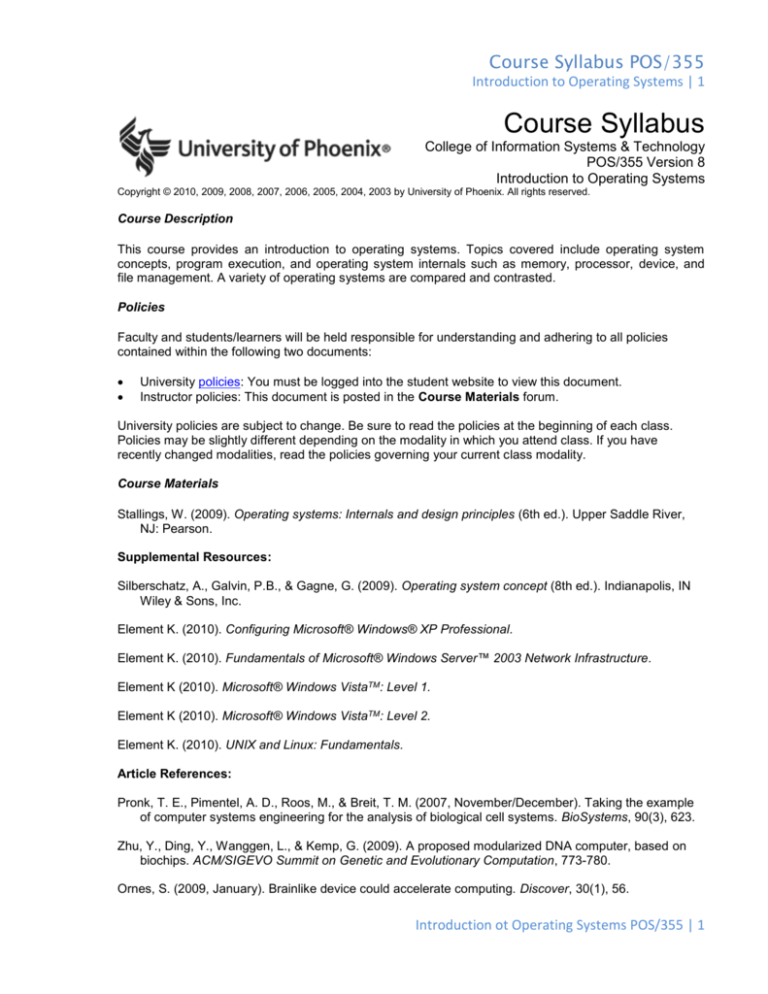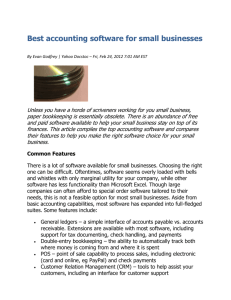
Course Syllabus POS/355
Introduction to Operating Systems | 1
Course Syllabus
College of Information Systems & Technology
POS/355 Version 8
Introduction to Operating Systems
Copyright © 2010, 2009, 2008, 2007, 2006, 2005, 2004, 2003 by University of Phoenix. All rights reserved.
Course Description
This course provides an introduction to operating systems. Topics covered include operating system
concepts, program execution, and operating system internals such as memory, processor, device, and
file management. A variety of operating systems are compared and contrasted.
Policies
Faculty and students/learners will be held responsible for understanding and adhering to all policies
contained within the following two documents:
University policies: You must be logged into the student website to view this document.
Instructor policies: This document is posted in the Course Materials forum.
University policies are subject to change. Be sure to read the policies at the beginning of each class.
Policies may be slightly different depending on the modality in which you attend class. If you have
recently changed modalities, read the policies governing your current class modality.
Course Materials
Stallings, W. (2009). Operating systems: Internals and design principles (6th ed.). Upper Saddle River,
NJ: Pearson.
Supplemental Resources:
Silberschatz, A., Galvin, P.B., & Gagne, G. (2009). Operating system concept (8th ed.). Indianapolis, IN
Wiley & Sons, Inc.
Element K. (2010). Configuring Microsoft® Windows® XP Professional.
Element K. (2010). Fundamentals of Microsoft® Windows Server™ 2003 Network Infrastructure.
Element K (2010). Microsoft® Windows VistaTM: Level 1.
Element K (2010). Microsoft® Windows VistaTM: Level 2.
Element K. (2010). UNIX and Linux: Fundamentals.
Article References:
Pronk, T. E., Pimentel, A. D., Roos, M., & Breit, T. M. (2007, November/December). Taking the example
of computer systems engineering for the analysis of biological cell systems. BioSystems, 90(3), 623.
Zhu, Y., Ding, Y., Wanggen, L., & Kemp, G. (2009). A proposed modularized DNA computer, based on
biochips. ACM/SIGEVO Summit on Genetic and Evolutionary Computation, 773-780.
Ornes, S. (2009, January). Brainlike device could accelerate computing. Discover, 30(1), 56.
Introduction ot Operating Systems POS/355 | 1
Course Syllabus POS/355
Introduction to Operating Systems | 2
Polakovic, J., & Stefani, J.-B. (2008, June). Architecting reconfigurable component-based operating
systems. Journal of Systems Architecture, 54(6), 562.
Elerath, J. (2009, June). Hard-disk drives: The good, the bad, and the ugly. Communications of the ACM,
52(6), 38.
Thibodeau, P. (2008, February 18). Mainframes fight to keep corporate IT crown. Computerworld, 42(8),
12.
Brooks, J. (2009, May 18). XP mode advantage. eWeek, 26(9), 40.
Vizard, M. (2009, January/February). Bridging the server divide. Baseline, (92), 15.
Stallman, R. (2009, June). Why "open source" misses the point of free software. Communications of the
ACM, 52(6), 31.
Strohmeyer, R. (2008, July). True or false: Linux is immune to malware and viruses. PC World, 26(7),
117.
Yalta, T. A., & Lucchetti, R. (2008, March). The GNU/Linux platform and freedom respecting software for
economists. Journal of Applied Econometrics, 23(2), 279.
All electronic materials are available on the student website.
Week One: Computer System
Details
Due
Points
Objectives
1.1 Identify and define components of a computer system.
Readings
Read Ch. 1, “Computer System Overview,” of Operating Systems:
Internals and Design Principles.
Read Ch. 2, “Operating System Overview,” of Operating Systems:
Internals and Design Principles.
Read this week’s Electronic Reserve Readings.
Participation
Participate in class discussion.
2
Discussion
Questions
Respond to weekly discussion questions.
2
Learning
Team
Instructions
Create the Learning Team Charter.
The Learning Team will prepare an 8-12 page paper that
compares and contrasts Windows® XP, Windows® 2003, and
Linux. In addition, the Learning Team will prepare a Microsoft®
PowerPoint® presentation of the project. The paper and
presentation are due in Week Five.
Introduction ot Operating Systems POS/355 | 2
Course Syllabus POS/355
Introduction to Operating Systems | 3
Week Two: Operating Systems
Details
Due
Points
Objectives
2.1 Identify and define components of an operating system (OS)
2.2 Explain memory management.
2.3 Explain processor management.
Readings
Read Ch. 3, “Process Description and Control,” of Operating
Systems: Internals and Design Principles.
Read Ch. 7, “Memory Management,” of Operating Systems:
Internals and Design Principles.
Read Ch. 8, “Virtual Memory,” of Operating Systems: Internals
and Design Principles.
Read Ch. 9, “Uniprocessor Scheduling,” of Operating Systems:
Internals and Design Principles.
Read Ch. 10, “Multiprocessor and Real-Time Scheduling,” of
Operating Systems: Internals and Design Principles.
Read this week’s Electronic Reserve Readings.
Participation
Participate in class discussion.
2
Discussion
Questions
Respond to weekly discussion questions.
2
Learning
Team
Instructions
Begin work on the Operating System Analysis.
Individual
Huffman
Trucking
Paper
Write a 1-2 page paper describing the operating systems used by
Huffman Trucking.
Address the following questions in your paper:
Outline the important features of Windows® XP.
15
Why do you think these operating systems were chosen?
What are the implications of the operating systems that are in
use by Huffman Trucking?
You can access the Huffman Trucking website from the Virtual
Organizations Portal. (Hint: Look at network diagrams.)
Week Three: Operating Systems
Details
Objectives
Due
Points
3.1 Explain device management.
3.2 Explain file management.
3.3 Define the role of main frames.
Introduction ot Operating Systems POS/355 | 3
Course Syllabus POS/355
Introduction to Operating Systems | 4
Readings
Read Ch. 11, “I/O Management and Disk Scheduling,” of
Operating Systems: Internals and Design Principles.
Read Ch. 12, “File Management,” of Operating Systems: Internals
and Design Principles.
Read this week’s Electronic Reserve Readings.
Participation
Participate in class discussion.
2
Discussion
Questions
Respond to weekly discussion questions.
2
Learning
Team
Instructions
Continue work on the Operating System Analysis.
Individual
PC/Mainframe
Paper
Write a 2-3 page paper comparing and contrasting PCs and
mainframes. It will be necessary to research this topic outside
your course readings.
Outline the important features of Windows® 2003.
15
Week Four: Windows Server®
Details
Due
Points
Objectives
4.1 Explain the basics of the Windows Server operating system.
Readings
Read Ch. 4, “Threads, SMP, and Microkernels,” of Operating
Systems: Internals and Design Principles.
Read Ch. 5, “Concurrency: Mutual Exclusion and
Synchronization,” of Operating Systems: Internals and Design
Principles.
Read Ch. 6, “Concurrency: Deadlock and Starvation,” of
Operating Systems: Internals and Design Principles.
Read this week’s Electronic Reserve Readings.
Participation
Participate in class discussion.
2
Discussion
Questions
Respond to weekly discussion questions.
2
Learning
Team
Instructions
Continue work on the Operating System Analysis.
Individual
Operating
Systems
Analysis Paper
Write a 2-4 page paper describing operating systems that are
common on the Internet. It is necessary to research this topic
outside your course readings.
Outline the important features of Linux.
Begin work on the Microsoft® PowerPoint® presentation.
20
Introduction ot Operating Systems POS/355 | 4
Course Syllabus POS/355
Introduction to Operating Systems | 5
Week Five: UNIX®
Details
Due
Points
Objectives
5.1 Explain the basics of the UNIX operating system.
5.2 Compare and contrast Windows XP®, Windows 2003®, and
Linux®.
Readings
Read Ch. 16, “Distributed Processing, Client/Server, and
Clusters,” of Operating Systems: Internals and Design Principles.
Read this week’s Electronic Reserve Readings.
Participation
Participate in class discussion.
2
Discussion
Questions
Respond to weekly discussion questions.
2
Learning
Team
Learning Team
Project
Complete work on the Operating System Analysis.
30
Complete and submit the 8-12 page paper that compares and
contrasts Windows® XP, Windows® 2003, and Linux.
Complete and submit the Microsoft® PowerPoint®
presentation.
Optional Discussion Questions
Week One Discussion Questions
What are some of the many considerations in selecting the correct information system to use for
trading futures and stocks?
Is service-oriented architecture (SOA) a new solution to information technology, or is it a new name
for the rehash of providing the user with what the user wants? Explain.
Based on the article by Pronk, et al. (2007), especially Figure 1, what are the general functions of
processors, software, and networks? What is the classical (von Neumann) architecture of a computer
system?
Based on the article by Zhu, et al. (2009), what components or modules of a standard electronic
computer system might be engineered into a bio-chip? What problem in the development of future
electronic computer does the developing bio-chip technology address?
Week Two Discussion Questions
Do you agree or disagree that throughput and capacity are determining factors for effectiveness of a
system more so than processor speed? Why or why not?
What security issues must be resolved now which cannot wait for the next version of Windows® to
arrive? Are we looking at a patch or a workaround to solve the present issues?
Based on Ornes’ (2009) article, what are the improvements that a memristor might have over current
physical and electronic storage devices? Is a memristor a green technology?
Introduction ot Operating Systems POS/355 | 5
Course Syllabus POS/355
Introduction to Operating Systems | 6
Based on the article by Polakovic and Stefani (2008), what are the main requirements to reconfigure
software on the fly? How do the authors define a computer component?
Week Three Discussion Questions
Based on Elerath’s (2009) article, what are the two main categories of hard disk drive failure? How
does SMART technology work, and what does it mean when limits are exceeded?
Based on Thibodeau’s (2008) article, what are the advantages and disadvantages of the use of
mainframes?
Week Four Discussion Questions
Does a new software product always provide a fundamental improvement to the system where we
install the new software product? What could some of the gains include?
Based on the article by Jason Brooks (2009), what capability will XP Mode in the Windows 7®
operating system add to PCs? What computer system hardware resource(s) may need to be
enhanced to use this capability?
Based on the article by Michael Vizard (2009), why is the Hyper-V virtualization technology available
in Windows® Server 2008 an important resource for many businesses IT environments? What role
does SUSE Linux play?
Week Five Discussion Questions
Why or why not would you agree that Novell® partnering with Linux will now present a viable
alternative to Microsoft® in the business world?
Because there are alternatives between Microsoft®, Linux, and Macintosh®, what would make an
individual choose one alternative over the other?
Based on Stallman’s (2009) article, what is the difference between the terms freeware and opensource software? Which of these two terms will you use in the future? Explain your preference for the
term.
Based on the article by Robert Strohmeyer (2008), is malware a threat in an online Linux OS
environment? What factor might influence the threat of malware to Linux systems that run web
servers?
Based on Yalta and Lucchetti’s (2008) article, what are the advantages and disadvantages of
adopting GNU/Linux?
Copyright
University of Phoenix® is a registered trademark of Apollo Group, Inc. in the United States and/or other countries.
Microsoft®, Windows®, and Windows NT® are registered trademarks of Microsoft Corporation in the United States and/or other
countries. All other company and product names are trademarks or registered trademarks of their respective companies. Use of
these marks is not intended to imply endorsement, sponsorship, or affiliation.
Edited in accordance with University of Phoenix® editorial standards and practices.
Introduction ot Operating Systems POS/355 | 6








